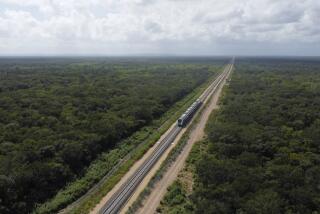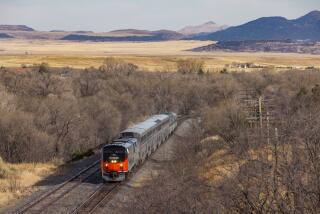Train trips: when time is not of the essence
- Share via
If you fly enough, you’ll have an airline epiphany. Mine came the day I was bumped from my original flight, talked my way onto an overcrowded later one, then cringed through two straight hours of turbulence.
After earning hundreds of thousands of frequent-flier miles in the last 20 years, I’d had it. I decided to find out whether the train was a viable alternative for business travel.
My test, a Los Angeles-to-Chicago trip on Amtrak’s Southwest Chief, offered some eye-opening comparisons.
Were the train’s higher fare and greater travel time worth avoiding airport hassles, flying jitters and crowding? Not entirely. Was seeing the heartland of America at 79 mph through a train window all it’s cracked up to be? Absolutely.
In the end, I didn’t regret the experience, but I’m not sure I’d do it again.
The journey begins
The round-trip coach train fare to Chicago cost $300, about the same as coach airfare. The thought of spending 44 hours sitting upright -- the seats recline but not all the way -- made a private sleeper appealing, so I paid an extra $1,000 for the upgrade. That’s a lot of money, but I thought it worthwhile considering the increase in comfort and privacy for two days and nights each way.
Amtrak’s Southwest Chief runs daily, traversing the Southern California deserts, Arizona, New Mexico, Colorado, Kansas, Missouri and Iowa before reaching Chicago.
Along the way, I saw young horses racing the train in Arizona, Native American homes in New Mexico, trestles over the Missouri and Mississippi rivers, and boxcar graffiti so striking that it blurred my definitions of tagger and artist.
I arrived at a nearly empty Union Station at 6 p.m. on a Sunday, about an hour before my train’s scheduled departure.
I was surprised at the nonchalance of the boarding process. The 30 sleeper car passengers and the 150 or so coach passengers were ushered down a long corridor toward the tracks. I assumed there would be metal detectors and X-ray machines, but no. Amtrak uses bomb-sniffing dogs, and its own police force that coordinates with local police departments.
Less than 10% of passengers on the Southwest Chief are business travelers. Contrast that with Amtrak’s shorter-distance routes in the Northeast, where many ride the rails for business.
Just like with an airplane, taking the train doesn’t always mean you’ll be on time. Delays often occur. Unlike the airlines, Amtrak hold-ups are not usually weather-related. Amtrak owns the rail lines in its Boston-to-Washington Northeast corridor, but elsewhere it has to share the tracks owned by the freight railroads. As a result, Amtrak trains often must stop to allow freight trains to pass. Amtrak says its trains arrive on schedule 70% of the time nationwide, but that figure drops to below 60% on long-distance routes such as the Southwest Chief. Major airlines, by comparison, arrive on schedule about 75% of the time.
My worries about security and the slowness of the journey disappeared when I saw the Southwest Chief, which instantly brought out the 12-year-old in me. A conductor looked at my ticket and pointed toward my sleeper car.
Sleeper compartments come in four varieties: standard, deluxe, family and handicapped. Standard sleepers, located on both levels, have only a narrow upper bunk and two convertible chairs below. Deluxe sleepers -- all on the quieter upper level -- have wider chairs and beds, plus a sink and an odd toilet that doubles as a shower. On the lower level are two larger rooms, a family bedroom and a handicapped room.
These two rooms stretch the full width of the car, allowing a both-sides-of the-train view. By the end of the business trip I would experience three of the four rooms.
Amtrak’s well-known money woes were apparent from the moment I stepped aboard. Nothing on the train was falling apart, yet everything seemed minimized and spartan. The average passenger car is more than 20 years old, a fact evidenced by frayed curtain edges, misaligned doors and a cacophony of creaks and groans.
When I first saw my standard sleeper compartment I didn’t know whether to laugh or cry. Two seats faced each other, with a window in between. A fold-down bunk bed -- no window view -- was above. Sliding the curtained door closed, I realized there was barely enough room to turn around. I lowered the top bunk and used it as a shelf for my luggage. Could I handle two days of near-claustrophobia?
As we crept away from Los Angeles I wandered down the corridor and stared longingly into an unoccupied deluxe room. Ah, the extra space, the bigger bed, the private sink, toilet and shower. I yearned for an upgrade, mine for another $1,000 round-trip -- on top of the $1,300 I’d already spent.
Back in my compartment, the sleeper car attendant came by to say hello. I pressed $20 into his hands and asked with a wink if there were any unassigned deluxe compartments where he could move me.
“I’ll have to check,” he said, pocketing my tip. “But even if there was, I couldn’t move you until tomorrow morning.”
I tried to look on the bright side. The compartment was tiny yet fairly well equipped. Two full-size pillows made excellent back bolsters for sitting. The overhead light was complemented by two bedside reading lights. The door and window curtains could seal out unwanted light. And there was a small retractable table that fit my laptop perfectly.
I’d brought a four-outlet power strip that enabled me to power up both my laptop and cellphone from the compartment’s single electrical outlet. At some stops along the way the train’s power would shut down, including compartment lights, outlets and air conditioning, but I never ran out of juice.
I typed and read for the next two hours, taking breaks to look out the window. Trying to type or write while on an Amtrak train is much like doing the same while flying through turbulence. For most of the trip, the motion was noticeable and made standing difficult.
At 6 p.m. dinner was announced, and I made my way cautiously to the dining car.
Amtrak food was surprisingly good, but the service was mediocre. Sleeper car fares include three dining car meals each day. (You simply sign your name and compartment number on the bill.) I had an egg-substitute Denver omelet for breakfast, Angus beef burger or chicken salad for lunch, and halibut or stuffed chicken breast for dinner. A half-bottle of wine cost $10. Dinner was usually by reservation, offered earlier in the day by an attendant. Popular items went fast, so savvy travelers tended to eat earlier.
Next to the food, the best thing about eating aboard Amtrak was the conversation with table mates. Dining car space is tight, and all four seats at every open table must be filled. Each meal I met three new people.
A tight squeeze
At 11 p.m., I decided to turn in. Two hours later, I was still staring up at the carpeted underbelly of the upper bunk. Sleeping on a moving train makes sleeping on a plane seem simple. At 6 feet, 180 pounds, I’m not a huge guy, but the 28-inch wide foam mattress was too small for comfort.
The sun streamed through the window and woke me up around 7 a.m. Outside, the eastern Arizona countryside was whipping by. I freshened up and walked to the dining car for a breakfast of coffee, juice, eggs and potatoes.
Later that morning, the attendant told me I could move to an unoccupied deluxe sleeping car. I was elated. My hope that merely tipping the attendant would secure an upgrade evaporated when he told me I’d have to purchase the upgrade at the ticket counter during a stop in Albuquerque. I handed over $220, bringing my total fare to $1,520 -- which included reverting to the tiny standard sleeper for the trip home. If I’d booked the deluxe sleeper for the four-day round-trip, I would have paid $2,300. So the one-night upgrade fee was reasonable.
After meals or wandering through the train, returning to my new compartment was no longer depressing. Stretching out my legs, I typed on the laptop and took photographs of the countryside. The private sink and toilet were welcome, although the shower was essentially useless. Nestled in the same tiny, closed-door space as the toilet, the shower instructions said I should sit on the toilet and press a button that would emit 30-second bursts of fixed-temperature water from a nozzle above. The drain was on the floor between my feet. Um, no thanks.
My new 40-inch-wide bed made all the difference on the second night. I slept soundly and awoke refreshed. After breakfast we crossed the Missouri River, and around lunchtime we crossed the Mississippi.
Finally, Chicago’s skyscrapers came into view, and we soon pulled into Union Station -- on time -- around 3:30 p.m. After two days, I was looking forward to getting off the train. Still, compared with my typical fatigue after stepping off a crowded flight into Chicago’s O’Hare airport, I felt alert and relaxed.
For the train ride home, I decided to pay the $400 upgrade fee for the family bedroom. Doing the math I realized that I’d paid a total of $1,920 in train fare. That’s a lot of money, but it’s still only about half the cost of a first-class round-trip ticket.
Although lacking the private toilet of the deluxe room, the family bedroom is large, stretching across the width of the train.
The bed was comfortable -- a foot wider than the standard bed -- and I enjoyed being able to watch the countryside go by on both sides.
The two-day trip home to Los Angeles was uneventful, but it seemed to take forever. There is one reason most business travelers have decided to stick with the airlines, except for along Amtrak’s Northeast Corridor: The train takes too long.
For my next business trip, perhaps I’ll consider flying to my destination and taking the train home just for fun -- but only if I can spare the time.
More to Read
Sign up for The Wild
We’ll help you find the best places to hike, bike and run, as well as the perfect silent spots for meditation and yoga.
You may occasionally receive promotional content from the Los Angeles Times.






